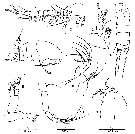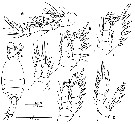|
|
 |
Fiche d'espèce de Copépode |
|
|
Platycopioida ( Ordre ) |
|
|
|
Platycopiidae ( Famille ) |
|
|
|
Antrisocopia ( Genre ) |
|
|
| |
Antrisocopia prehensilis Fosshagen, 1985 (F,M) | |
| | | | | | | Ref.: | | | Fosshagen & Iliffe, 1985 (p.354, Descr.F,M, figs.F,M); Huys & Boxshall, 1991 (p.33, 38, 435, 460, figs.F,M); Boxshall & Huys, 1998 (p.780) |  issued from : A. Fosshagen & T.M. Iliffe in Sarsia, 1985, 70. [p.354, Fig.7]. Female (from Roadside Cave, Bermuda): A, habitus (lateral); B, urosome (ventral, slightly pressed); C, A1; D, A2; E, Md; F, Mx1; G, Mx2; H, Mxp. Nota: Rostrum strong, ending in a single point. A2 exopod 8-segmented (some of which are partly fused); endopod 2-segmented, bearing 7 long terminal setae on the last segment.
|
 issued from : A. Fosshagen & T.M. Iliffe in Sarsia, 1985, 70. [p.355, Fig.8]. Female: A-E, P1 to P5. Male: F, habitus (dorsal); G, A1. Nota: A1 geniculate on both sides; there is a fusion leaving 9 free segments beyond the distended proximal part. No distinct structure of the urosome and P5 distinguishing male from the female was seen.
|
 Both A1 male geniculate. No sexual dimorphism in P5. A2 exopod indistinctly 8-segmented. Mx2 highly modified. Syncoxa of Mxp with 1 seta.
| | | | | NZ: | 1 | | |
|
Carte de distribution de Antrisocopia prehensilis par zones géographiques
|
| | | | Loc: | | | Bermuda Is. (Roadside cave) | | | | N: | 2 | | | | Lg.: | | | (385) F: 0,37-0,35; M: 0,35; 0,34; {F: 0,35-0,37; M: 0,34-0,35} | | | | Rem.: | For Fosshagen & Iliffe (1985, p.356) this species combines characters from both Gymnoplea and Podoplea. The position of the prosome-urosome articulation indicates that it belongs to the Gymnoplea. It is related to the aberrant genus Platycopia. The species has to be included in the family Platycopiidae because of the two spines on the outer margin of the 1st segment of the exopods. Further resemblance to Platycopia is found in the A1 with its distended proximal part and jointed aesthetascs, and in similarities of the Md and the Mx1. A1 are reminiscent of some misophrioids (for instance Misophria pallida). Bilateral, geniculate A1 of male podopleans seem to be combined with simple, symmetrical and similar P5 of both sexes. The P5 of A. prehensilis are, however, better developed than among podopleans, and they differ little from those of female Platycopia except for a particularly strong and dorsally directed spine on the 1st endopodal segment. This is an unusual modification and not present in female calanoids. Also the urosome of A. prehensilis deviates from that of calanoids, being 5-segmented in both sexes and with no recognizable sexual difference. Similarity of the urosome between sexes is also found in Platycopia, but the number of segments of both sexes is 4. In misophrioids, however, the number of urosomal segments posterior to P5 is 5 in both sexes. In this group, P6 or traces of such a limb are found. A possible explanation of the transverse structure seen in the 1st urosomal segment of A. prehensilis in both sexes might be traces of an intercoxal sclerite of P6.
A. prehensilis shows many plesiomorphic characters although it has specialized mouthparts. Most certainly it is a reptorial feeder and a bottom-dweller.
A. prehensilis agrees in many ways with the description made by Boxshall, Ferrari & Tiemann (1984) of a theorical ancestral copepod, having the same number of body segments, and with bilateral, geniculate A1 in the male as the only sexual dimorphism.
lang (1948) suggested placing Platycopiidae in its own suborder, Progymnoplea. This suggestion now gains support with the discovery of Antrisocopia | | | Dernière mise à jour : 29/12/2014 | |
|
|
 Toute utilisation de ce site pour une publication sera mentionnée avec la référence suivante : Toute utilisation de ce site pour une publication sera mentionnée avec la référence suivante :
Razouls C., Desreumaux N., Kouwenberg J. et de Bovée F., 2005-2025. - Biodiversité des Copépodes planctoniques marins (morphologie, répartition géographique et données biologiques). Sorbonne Université, CNRS. Disponible sur http://copepodes.obs-banyuls.fr [Accédé le 23 mai 2025] © copyright 2005-2025 Sorbonne Université, CNRS
|
|
 |
 |





